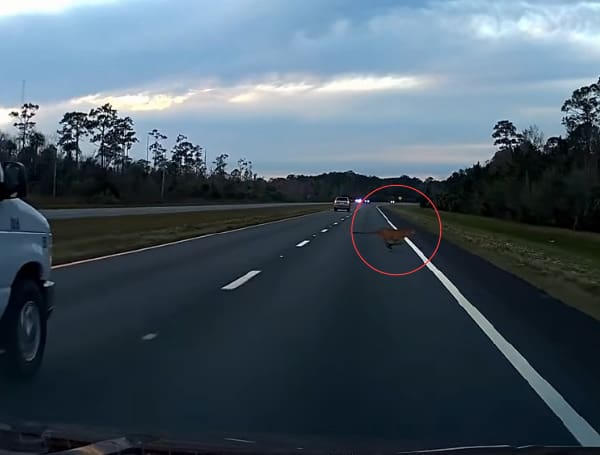The Florida panther, also known as the cougar or mountain lion, holds a special place in the natural heritage of Florida.
It is the only remaining population of pumas east of the Mississippi River.
The Florida Fish and Wildlife Commission (FWC) is asking drivers to pause for panthers after a dashcam video caught a majestic panther crossing a Florida highway.
According to the FWC, male Florida panthers are capable of dispersing great distances and have been documented throughout central Florida, generally south of the I-4 corridor.
“Kim Rivera shared this amazing dashcam on our Panther Sighting Database, showing a panther darting across SR 520 near Tosohatchee WMA,” posted the FWC. “Notice the van braking to allow the panther safe passage.”
This serves as a good reminder that while most panther-vehicle collisions occur in southwest Florida, being an alert driver wherever you are can help keep you, other motorists and wildlife safe.
If you see an injured, sick or dead panther, please report it to our Wildlife Alert Hotline at 888-404-FWCC (3922).
Historical Range and Identification
Historically, Florida panthers roamed across the southeastern United States, including states like Arkansas, Louisiana, Mississippi, Alabama, Georgia, Florida, and parts of Tennessee and South Carolina.
However, due to habitat loss, fragmentation, and human activities, the breeding population of Florida panthers is now confined to the southwestern tip of Florida. The unique characteristics of the Florida panther make it distinguishable from other subspecies of mountain lions.
Florida panthers have a distinctive appearance, with large, tan bodies covered in tawny-beige fur. They have a whitish-gray belly and chest, along with black markings on their tail tip, ears, and snout.
One notable feature of Florida panthers is the presence of a crooked tail and a patch of fur on the back that resembles a cowlick. However, it is important to note that these traits are a result of inbreeding and poor genetic variation, which have plagued the small population of Florida panthers in the past.
Read: Exploring Florida’s Hidden Natural Gems: A Unique Adventure
Behavior and Reproduction
Florida panthers are solitary and territorial animals, except during the mating season or when females are raising their young. They use pheromones and physical signs like claw markings and feces to mark their territory.
Male panthers have much larger territories, spanning over 200 to 250 square miles, while females have smaller ranges.
Mating season for Florida panthers occurs from November to March, during which males search for females to mate with. After breeding, the female is pregnant for approximately three months.
She gives birth to a litter of one to three kittens, although not all kittens survive to adulthood. At birth, the kittens are covered in dark spots, providing them with camouflage.
As they grow, these spots fade away, and they begin to resemble adult panthers. The kittens stay with their mother for about a year and a half before venturing out to establish their own territories.
Diet and Habitat
Florida panthers are carnivores, primarily feeding on white-tailed deer. They are skilled hunters, but they also prey on other medium-sized mammals like feral hogs, raccoons, and reptiles.
Panthers have adapted to a variety of warm climate habitats, including wetlands, swamps, upland forests, and areas with dense vegetation like saw palmetto.
Read: The Wild Hog Problem Can Be Found In Every County In The State Of Florida
Threats to Survival
The Florida panther faces numerous threats to its survival, making it one of the most endangered mammals in the country.
The major threat to their population is habitat loss, fragmentation, and degradation due to human activities such as clear-cutting and building.
These activities destroy the vast, unspoiled territories that panthers require to thrive.
Another significant threat to Florida panthers is roadway mortality, which limits their range expansion. Collisions with vehicles while searching for territory, food, and mates have resulted in numerous panther deaths.
Lack of landowner acceptance and understanding can also pose challenges to panther recovery efforts.
The small size and isolation of the panther population make them vulnerable to genetic problems and catastrophic events like disease outbreaks and exposure to toxins. In recent years, a fatal neuromuscular disorder has been observed among panthers and bobcats, further highlighting the need for conservation efforts.
Conservation Efforts
To protect the Florida panther and its habitat, various organizations and initiatives have been established to address the challenges they face. Defenders of Wildlife, a prominent conservation organization, has been at the forefront of panther recovery efforts for over four decades.
They lobbied for the inclusion of the Florida panther under the federal Endangered Species Act and have been working to secure and protect large interconnected tracts of wild land for panther expansion.
Defenders of Wildlife has also launched a panther coexistence program to address conflicts between panthers and humans. In rural neighborhoods, they fund and construct sturdy enclosures to protect pets and small livestock from panthers and other predators.
Collaboration with ranchers and the Panther Recovery Team has led to the improvement of incentive programs to compensate for monetary losses when panthers kill commercial livestock.
Current Status and Future Challenges
The Florida panther is currently listed as an endangered species under the Endangered Species Act. The International Union for Conservation of Nature (IUCN) also recognizes their vulnerable status.
With an estimated population of 120-230 adults and subadults primarily located in southwest Florida, the Florida panther’s future depends on range expansion and restoration of additional populations.
However, several challenges lie ahead for the recovery of the Florida panther. The small population size and low genetic diversity make them susceptible to disease and genetic disorders.
Habitat loss and the danger posed by roads and highways continue to threaten their survival. Addressing these challenges requires ongoing research, conservation efforts, and public support.
Help support the Tampa Free Press by making any small donation by clicking here.
Android Users, Click To Download The Tampa Free Press App And Never Miss A Story. Follow Us On Facebook and Twitter. Sign up for our free newsletter.


